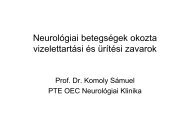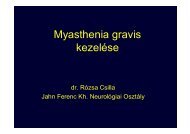Myasthenia gravis története
Myasthenia gravis története
Myasthenia gravis története
Create successful ePaper yourself
Turn your PDF publications into a flip-book with our unique Google optimized e-Paper software.
<strong>Myasthenia</strong> <strong>gravis</strong> <strong>története</strong><br />
(Dr. John Keesey 2002, at the Xth International<br />
Conference on <strong>Myasthenia</strong> Gravis and Related<br />
Disorders)<br />
Prof. Dr. Komoly Sámuel<br />
PTE Klinikai Idegtudományi Közont<br />
Neurológiai Klinika
A betegség elsı leírója :Thomas Willis 1672<br />
• he wrote about "a woman who temporarily lost her power<br />
of speech and became 'mute as a fish.'"(1) This has<br />
been interpreted as being the first written description of<br />
myasthenia <strong>gravis</strong><br />
• "Chief Opechancanough, a warrior chief, was<br />
responsible for several massacres in the (American)<br />
colonies his eyelids were too heavy that he could not see<br />
unless they were lifted up by his attendants. Further, he<br />
was unable to walk<br />
• Newsom-Davis szerint Sámsonnak is myastheniája<br />
volt…
Erb – a példakép (?)<br />
– Heinrich Erb (1840-1921), German neurologist,<br />
was responsible (in part) for the delineation of<br />
myasthenia <strong>gravis</strong>: He "described myasthenia<br />
<strong>gravis</strong> pseudoparalytica in 1878<br />
– called Erb-Goldflam-Oppenheim disease at the<br />
time."(3) „<br />
– For a half a century Wilhelm Heinrich Erb ruled<br />
over German Neurology with an imperial hand
Thymus hypertrophia és<br />
myasthenia (1901)<br />
• Carl Weigert, German pathologist and<br />
histologist, 1845-1904, is credited with<br />
drawing attention to the relation between<br />
hypertrophy of the thymus and<br />
myasthenia <strong>gravis</strong>. Recorded in<br />
1901."(3) Published in Neurologisches<br />
Zentralblatt, 20:597. (5) "
Thymectomia (1912)<br />
• Ernst Ferdinand Sauerbruch, German<br />
surgeon, 1875-1951, performed<br />
thymectomy for the relief of myasthenia<br />
<strong>gravis</strong>. Recorded by Schumacher and<br />
Roth in 1912.(3)
1934<br />
<strong>Myasthenia</strong> tüneti kezelésének felfedezése<br />
• Mary Broadfoot Walker (1896-1974),<br />
• She introduced the use of physostigmine<br />
in the treatment of myasthenia <strong>gravis</strong>.<br />
Recorded in 1934
Mi adta az ötletet?<br />
• "Surmising that, since MG had symptoms<br />
like curare poisoning: the curare antidote<br />
physostigmine might help it, she injected<br />
physostigmine into her very droopy<br />
patients (OGYI engedély?.... GCP…?)<br />
• Then, with utter drama, like Lazarus rising<br />
from the grave, they rose and walked<br />
across the room.
Pont egy nı, a Britt Birodalom nagy<br />
• "In an era when women<br />
were not admitted to the<br />
University of Edinburgh<br />
and when England's first<br />
female physician<br />
(Elizabeth Garrett<br />
Anderson, 1836-1917)<br />
had to venture to Paris,<br />
France, to earn her M.D.<br />
in 1870, She is credited<br />
with making the most<br />
significant discovery in<br />
medical therapeutic<br />
within the British empire.<br />
bánatára ….
A terápia mechanizmusa: az<br />
acetylcholin lebontásának a<br />
gátlása: Nobel díj<br />
• Sir Henry Dale (1875-1968) came in the<br />
recognition of drugs such as physostigmine,<br />
drugs that block the enzymatic destruction of<br />
acetylcholine, and so allow this substance to<br />
accumulate in cases of deficiency, as in<br />
myasthenia <strong>gravis</strong>.„<br />
• Dale shared in the Nobel Prize in 1936 for<br />
developing the theory of neurohumoral<br />
transmission.
„azok a hatvanas évek…”<br />
• It was only in the 1960s that Drs Jacques Miller (London and Australia) and<br />
Bob Good (USA) finally showed that the thymus was a key ‘immune<br />
organ’.<br />
• At the same time, it had become clear that several other disorders were<br />
caused by an immune attack on the patients’ own tissues, for example<br />
thyroid disease. In 1959, another beloved former Vice-President, Prof Iain<br />
Simpson, was reviewing all the thymectomies he could trace in Glasgow<br />
and London (404 in all).<br />
• He noticed that such ‘autoimmune’ diseases are specially common in<br />
relatives of myasthenics.<br />
• He remembered that short-term MG could also be transferred from mother<br />
to newborn baby, just like protective antibodies are passed across.<br />
• So Simpson he proposed, in 1960, that MG was autoimmune too. He<br />
was 12 years ahead of his time.
1973<br />
elektrofiziológusok: az achetylcholin<br />
receptorhoz kötıdik<br />
• These two tracks finally came together in<br />
1973. By then, physiologists realised that<br />
the ACh, the ignition keys, must somehow<br />
latch into specialised ACh receptors<br />
(AChRs) – the ignition locks.
1975<br />
<strong>Myasthenia</strong> szérummal átvihetı<br />
Science. 1975 Oct 24;190(4212):397-9<br />
• <strong>Myasthenia</strong> <strong>gravis</strong>: passive transfer from<br />
man to mouse. Toyka KV, Brachman DB,<br />
Pestronk A, Kao I.
1975<br />
Kísérletes autoimmun myasthenia<br />
J Exp Med. 1975 :141:1365-75<br />
• Immunization of animals with acetylcholine receptor<br />
(AChR) protein from the electric organs of Electrophorus<br />
electricus and Torpedo californica induces an<br />
autoimmune response to the AChR of mammalian<br />
skeletal muscle.<br />
• Rats and guinea pigs develop experimental autoimmune<br />
myasthenia <strong>gravis</strong> (EAMG) after a single inoculation with<br />
small quantities of AChR and adjuvant<br />
• Physostigminre tüneteik javultak
2001<br />
muscle-specific receptor tyrosine kinase,<br />
MuSK<br />
Nat Med. 2001:7:365-8<br />
• Auto-antibodies to the receptor tyrosine kinase MuSK in<br />
patients with myasthenia <strong>gravis</strong> without acetylcholine<br />
receptor antibodies. Hoch W, McConville J, Helms S,<br />
Newsom-Davis J, Melms A, Vincent A.<br />
• MuSK ellenanyag pozitív a<br />
„szeronegatív” betegek fele (~7%)<br />
• AChR ellenanyag pozitív ~ 73%
Magyarország<br />
• Szobor Albert: <strong>Myasthenia</strong> <strong>gravis</strong> Akadémiai<br />
Könyvkiadó, 1990<br />
• SZA elsı betege: 1951, akinél az elsı<br />
magyarországi thymectómia is megtörtént:<br />
Sebestyén Gyula,<br />
• Nyírı Gyula támogatta SZA tevékenységét<br />
• Plasmepheresis bevezetése<br />
• Diagnosztika bevezetése<br />
• Betegek összegyőjtése, gondozása<br />
• Országos központ létrehozása
<strong>Myasthenia</strong> in a patient with sarcoidosis<br />
and schizophrenia. Ideggyogy Sz. 2004 Jul 20;57(7-8):242-4.<br />
• Rozsa C,<br />
• Kis G,<br />
• Komoly S,<br />
• Anselmo V,<br />
• Esik O,<br />
• Lang I,<br />
• Kas J,<br />
• Nemeth G,<br />
• Solymosi D,<br />
• Svasztics E,<br />
• Szentirmay Z,<br />
• Szobor A,<br />
• Telekes A;<br />
• Hungarian <strong>Myasthenia</strong> Thymoma Research Group.
John Newsom-Davis<br />
• Plasmapheresis bevezetése<br />
• ’60-as években a szteroid kezelés<br />
bevezetése<br />
• Szteroid-Imran kombinált kezelés<br />
bevezetése, evidenciákra helyezése
Áttörés a myasthenia kezelésében<br />
(John Newsom-Davis)<br />
M e d r o l - I m u r a n kombinációs kezelés<br />
I m u r a n 2.5 mg/tkg – 3- 5(?) évig … ……<br />
M e s t i n o n<br />
(max 5x1 tbl)<br />
40 mg<br />
32 mg<br />
24 mg<br />
16 mg<br />
másodnaponta<br />
M e d r o l<br />
1 mg/kg 1-3 hónapig<br />
Csökkentés üteme:<br />
kéthetente 4 mg<br />
Hónapok, néha évek






